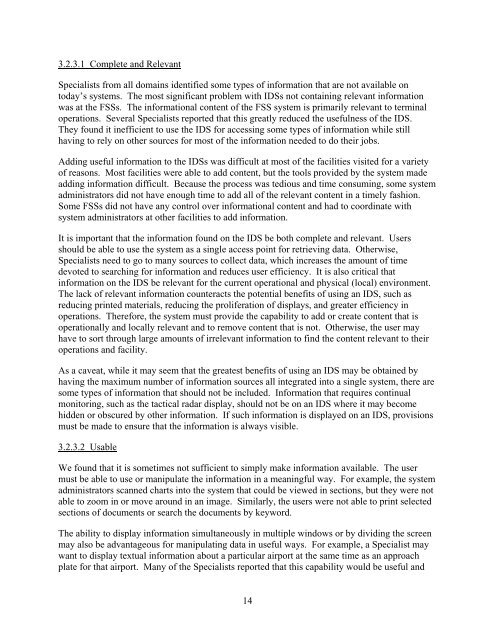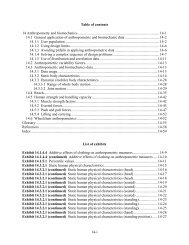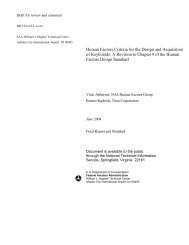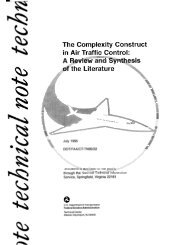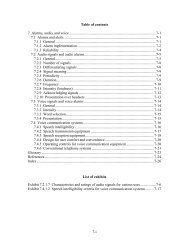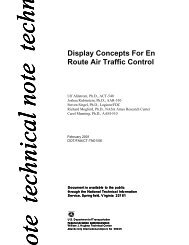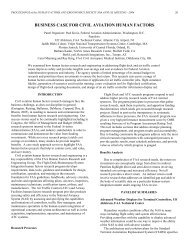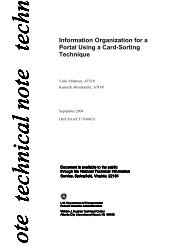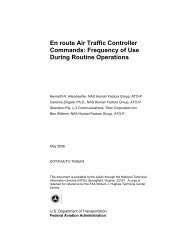Design of information Display Systems for Air Traffic Control - FAA
Design of information Display Systems for Air Traffic Control - FAA
Design of information Display Systems for Air Traffic Control - FAA
Create successful ePaper yourself
Turn your PDF publications into a flip-book with our unique Google optimized e-Paper software.
3.2.3.1 Complete and Relevant<br />
Specialists from all domains identified some types <strong>of</strong> <strong>in<strong>for</strong>mation</strong> that are not available on<br />
today’s systems. The most significant problem with IDSs not containing relevant <strong>in<strong>for</strong>mation</strong><br />
was at the FSSs. The <strong>in<strong>for</strong>mation</strong>al content <strong>of</strong> the FSS system is primarily relevant to terminal<br />
operations. Several Specialists reported that this greatly reduced the usefulness <strong>of</strong> the IDS.<br />
They found it inefficient to use the IDS <strong>for</strong> accessing some types <strong>of</strong> <strong>in<strong>for</strong>mation</strong> while still<br />
having to rely on other sources <strong>for</strong> most <strong>of</strong> the <strong>in<strong>for</strong>mation</strong> needed to do their jobs.<br />
Adding useful <strong>in<strong>for</strong>mation</strong> to the IDSs was difficult at most <strong>of</strong> the facilities visited <strong>for</strong> a variety<br />
<strong>of</strong> reasons. Most facilities were able to add content, but the tools provided by the system made<br />
adding <strong>in<strong>for</strong>mation</strong> difficult. Because the process was tedious and time consuming, some system<br />
administrators did not have enough time to add all <strong>of</strong> the relevant content in a timely fashion.<br />
Some FSSs did not have any control over <strong>in<strong>for</strong>mation</strong>al content and had to coordinate with<br />
system administrators at other facilities to add <strong>in<strong>for</strong>mation</strong>.<br />
It is important that the <strong>in<strong>for</strong>mation</strong> found on the IDS be both complete and relevant. Users<br />
should be able to use the system as a single access point <strong>for</strong> retrieving data. Otherwise,<br />
Specialists need to go to many sources to collect data, which increases the amount <strong>of</strong> time<br />
devoted to searching <strong>for</strong> <strong>in<strong>for</strong>mation</strong> and reduces user efficiency. It is also critical that<br />
<strong>in<strong>for</strong>mation</strong> on the IDS be relevant <strong>for</strong> the current operational and physical (local) environment.<br />
The lack <strong>of</strong> relevant <strong>in<strong>for</strong>mation</strong> counteracts the potential benefits <strong>of</strong> using an IDS, such as<br />
reducing printed materials, reducing the proliferation <strong>of</strong> displays, and greater efficiency in<br />
operations. There<strong>for</strong>e, the system must provide the capability to add or create content that is<br />
operationally and locally relevant and to remove content that is not. Otherwise, the user may<br />
have to sort through large amounts <strong>of</strong> irrelevant <strong>in<strong>for</strong>mation</strong> to find the content relevant to their<br />
operations and facility.<br />
As a caveat, while it may seem that the greatest benefits <strong>of</strong> using an IDS may be obtained by<br />
having the maximum number <strong>of</strong> <strong>in<strong>for</strong>mation</strong> sources all integrated into a single system, there are<br />
some types <strong>of</strong> <strong>in<strong>for</strong>mation</strong> that should not be included. In<strong>for</strong>mation that requires continual<br />
monitoring, such as the tactical radar display, should not be on an IDS where it may become<br />
hidden or obscured by other <strong>in<strong>for</strong>mation</strong>. If such <strong>in<strong>for</strong>mation</strong> is displayed on an IDS, provisions<br />
must be made to ensure that the <strong>in<strong>for</strong>mation</strong> is always visible.<br />
3.2.3.2 Usable<br />
We found that it is sometimes not sufficient to simply make <strong>in<strong>for</strong>mation</strong> available. The user<br />
must be able to use or manipulate the <strong>in<strong>for</strong>mation</strong> in a meaningful way. For example, the system<br />
administrators scanned charts into the system that could be viewed in sections, but they were not<br />
able to zoom in or move around in an image. Similarly, the users were not able to print selected<br />
sections <strong>of</strong> documents or search the documents by keyword.<br />
The ability to display <strong>in<strong>for</strong>mation</strong> simultaneously in multiple windows or by dividing the screen<br />
may also be advantageous <strong>for</strong> manipulating data in useful ways. For example, a Specialist may<br />
want to display textual <strong>in<strong>for</strong>mation</strong> about a particular airport at the same time as an approach<br />
plate <strong>for</strong> that airport. Many <strong>of</strong> the Specialists reported that this capability would be useful and<br />
14


